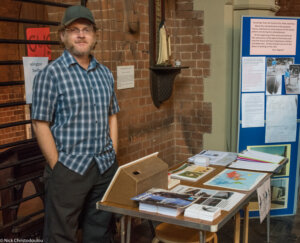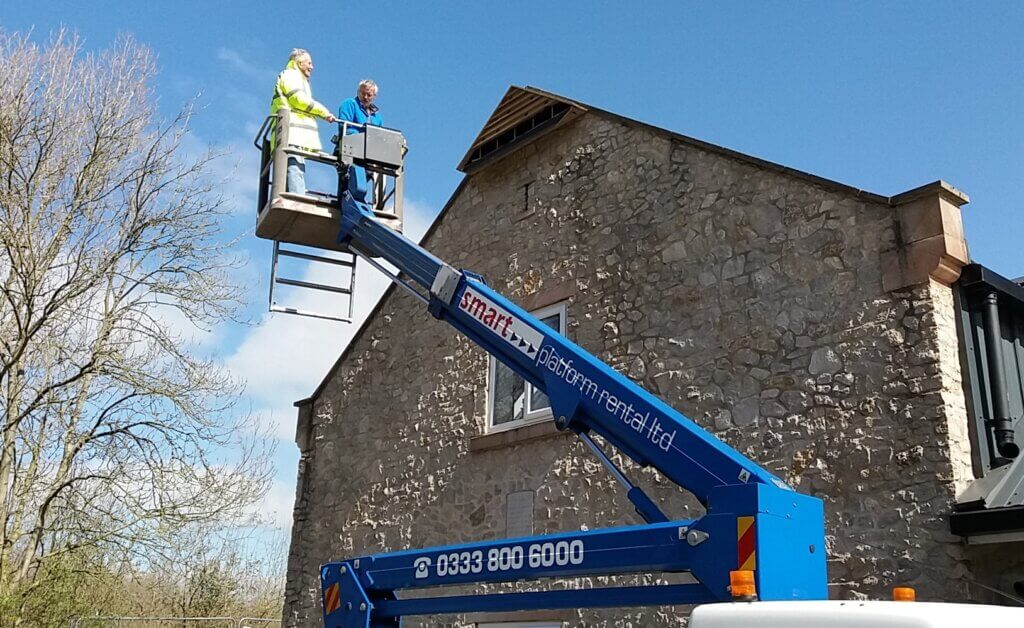
Mike Priaulx is a sustainable buildings consultant who founded the Islington Swifts Group in 2016.
Working with the Council, residents and local organisations, there are now more than 200 new nesting spaces for swifts in the borough. His twitter handle: @islingt_swifts

Why do we need Swift Awareness Week?
There are many other similarly endangered species that were once common – turtle doves, corn buntings, nightingales etc. But these species perhaps feel beyond our reach. Even if we are lucky enough to live near them, what can we as individuals with a small house and garden do to help them?
However, the survival of swifts is very much in our hands. This urban species just needs our homes to nest, and our gardens and trees to provide insects. But humans have a slightly controlling attitude to wildlife. We partition them into reserves and protected areas. Even more so when it comes to our homes – we might have shared them with wildlife since our earliest beginnings but now we want our houses to be exclusively ours. Wildlife is welcome in our gardens but only the right kind of wildlife and at our invitation.

So swifts (along with along with other building-dependent species… sparrows, starlings, swallows, house martins etc.) now find themselves in a difficult position. Luckily many people love these species and welcome them into their buildings. But some don’t. This is a particular problem for species such as swifts which have a traditional building that they use year after year. Once excluded, they find it particularly difficult to find another.
One building can be a key site for a species but it has no protection under law. Whilst bat roosts are well known to be protected (even when no bats are present), birds’ nests only have that protection when they are being actively used (under the 1981 Wildlife & Countryside Act).
With dwindling restrictions on modifications to our properties, there are very few statutory controls at all, and it’s often the case that renovation, refurbishment and extension work is carried out in summer, just when swifts are nesting. These are a problem as modern materials remove the nooks and crannies that swifts use (more so than insulation, which can be accommodated alongside nesting spaces with a little thought). But these changes also provide new opportunities to create spaces in bricks and eaves for long-term occupation by swifts, other urban birds and bats too.

But minor renovations offer danger with little reward for wildlife already on a knife-edge in many areas. These damaging building works are often undertaken legally. Exclusion mid-way through the breeding season can be fatal, and whilst this is not legal, enforcement is very hard to achieve once work is underway.
So, what to do when scaffolding pops up mid-season? The Wildlife Crime units of the police are there to help, so don’t feel that it must be an intentional crime to contact them. The RSPCA may also assist. Where local residents are concerned, then team up with them as reputable contractors are keen to stay on the right side of the neighbours, perhaps more so than for an external conservation organisation.

Of course, not everyone feels the same way about wildlife. And everyone (with the admirable exception of ethical vegans, and followers of the Jain religion) draws the line somewhere in terms of our attitude to wildlife. So personally it is not something I am angry about. The protection of active nest sites is a legal matter so emotion does not need to be involved. Usually ignorance is the main problem. So although there is not a right or wrong answer about this, my approach would be to let people know that swifts are nesting ideally before any work begins.
A friendly chat if you know them or a note through the door explaining the plight of swifts, why they are such amazing birds (the fastest species in level flight, able to live for twenty years, eating thousands of biting insects a day, and with fledglings able to make their maiden flights to Africa with no adult to guide them… and find their way back too!).
For every one person who might not want the birds nesting, in my experience at least, nine will want to keep them and maybe do something more. I know of at least one occasion where a resident building an extension who was previously unaware of swifts nesting in their house, was sufficiently keen on their presence to both protect them and install nesting bricks in their new building.
Dealing with organisations is different. They are often willing to make changes though bureaucracy is a major hurdle to overcome. If you’re not making progress, then some social media pressure may be a useful tool perhaps if the relevant authorities don’t seem to be taking the action that they should be fast enough.
It is important that organisations are informed where possible beforehand about relevant nesting sites – churches, schools, Housing Associations. It shouldn’t be assumed that someone will know – the capacity to miss the obvious should never be underestimated! It is even harder to make sure that these organisations stay aware as staff depart and arrive – take every opportunity to remind them. Get more than one member of staff involved. Invite them to a meeting or hold an event!

brick. Photo: Mike Priaulx
With net gain for biodiversity being enshrined in English planning guidance now (NPPF 2019), and swift bricks and bat boxes now also being promoted by the government (NPPG Natural Environment 2019), we can hopefully look forward to a future where nest sites are not a limiting factor for swifts and other building-dependent species. Then we can think about food supply!
For more information about Swift Awareness Week 2020 (which runs to 5th July): search for @swiftsweek or #swiftawarenessweek, or get in touch with one of the 93 local swift groups around the UK (https://actionforswifts.blogspot.com/p/sln.html)

Interesting piece, Mike. Thank you.
Having focused on nest site/behavioural data collection around Stratford-upon-Avon and this season moving into liaison and potential interventions, your article hits the spot, Mike.
Also to coincide with Swift Awareness Week, see Mark Cocker’s Country Diary in today’s Guardian:
https://www.theguardian.com/environment/2020/jun/30/country-diary-are-all-our-swifts-out-for-the-count the online version of which has a superb set of photos attached, taken by Nick Upton.
Interesting blog Mike.
What is the situation regarding cleaning out these Swift bricks, do they need clearing out in the same way as timber nest boxes which are emptied of debris every couple of years in our garden?
Happily, swift bricks and nestboxes don’t need cleaning out – the swifts will maintain their nest as they like it over the years.
Excellent blog!
Mike’s early point about our practice of “partitioning wildlife into reserves and protected areas” is worthy of further discussion.
Creation of ‘reserves’ – notably by the RSPB and the county wildlife trusts – is entirely well-meant and often beneficial, particularly to certain target species, but there is a downside.
People, especially children, are inadvertently encouraged to believe that wildlife occurs on reserves – but nowhere else.
If the UK’s planning system was more imaginative, wildlife would be accommodated across the whole fabric of the country’s geography and ‘reserves’ would be unnecessary.
Hi James, in my experience children find wildlife in all sorts of places; a ladybird larvae on the trunk of a tree in the school playground, an insect gall on a leaf, a snail on a flower pot….
As a teacher in an infant school, I regularly take my class out on walks around the local area, (as do other teachers in the school), and even though we have very limited green space around us we always spot plenty of wildlife. Last week we were excited to see a buzzard passing overhead and by the discovery of a magpie moth in the grass. We stopped to check for caterpillars on a patch of nettles, listened to a robin singing in a hedgerow and watched the blackbirds using the children’s play area as a lookout post. We have spent time spotting and counting the swifts flying above the playground and learnt about where they nest. The children have asked fantastic questions about them and compared them to the ospreys and peregrines we have watched on webcams elsewhere. This afternoon they have designed and made posters to help ‘Save our Swifts’. Tomorrow we will display them on the school fence ….
If more developers would cater for building dependent species like Swifts, Sparrows, Swallows and Martins we could arrest their decline I’m sure. There’s lots of opportunities within the built environment, less grass cutting, thoroughfares for Hedgehogs, native planting, etc. People need educating to stop tidying up nature and make more space for other species. Mike has a wealth of information on providing spaces for Swifts in new builds I hope his knowledge can be spread far and wide!
Hi i have just put up two swift box’s in my eve hopeing to get my first pair in May be next year let’s hope
If you can play the sound of swifts, even just from a phone or laptop somewhere beneath the box, then that will help them to be occupied much more quickly. Choose a volume level that won’t disturb your neighbours! Action for Swifts provide some information here, including a link to Swift Conservation who can provide the calls file for a nominal fee:
http://actionforswifts.blogspot.com/p/attraction-call-systems-for-swifts.html
Helen’s comment is very encouraging – here’s hoping her pupils’ interest in nature and wildlife continues into adulthood. And congratulations to her and colleagues for all the great work they are doing.
In response to this Swift week you can now read ‘Screamer the Swift’ on You Tube. More of my books will be added soon.
https://www.youtube.com/watch?v=6nokw5m0vgo&feature=youtu.be
Another point, if you want to see Swifts in numbers, Check out your Oil seed rape fields for them feeding on a beetle which is the most sprayed species in Britain! Another reason for decline?